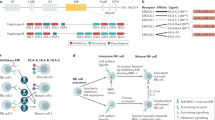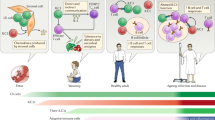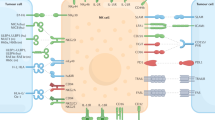Abstract
Although natural killer (NK) cells are defined as a component of the innate immune system, they exhibit certain features generally considered characteristic of the adaptive immune system. NK cells also participate directly in adaptive immune responses, mainly by interacting with dendritic cells. Such interactions can positively or negatively regulate dendritic cell activity. Reciprocally, dendritic cells regulate NK cell function. In addition, 'NK receptors' are frequently expressed by T cells and can directly regulate the functions of these cells. In these distinct ways, NK cells and their receptors influence the adaptive immune response.
This is a preview of subscription content, access via your institution
Access options
Subscribe to this journal
Receive 12 print issues and online access
$209.00 per year
only $17.42 per issue
Buy this article
- Purchase on Springer Link
- Instant access to full article PDF
Prices may be subject to local taxes which are calculated during checkout

K.R.

K.R.

K.R.
Similar content being viewed by others
References
Trinchieri, G. Biology of natural killer cells. Adv. Immunol. 47, 187–376 (1989).
Biron, C.A., Nguyen, K.B., Pien, G.C., Cousens, L.P. & Salazar-Mather, T.P. Natural killer cells in antiviral defense: function and regulation by innate cytokines. Annu. Rev. Immunol. 17, 189–220 (1999).
Lanier, L.L. NK cell receptors. Annu. Rev. Immunol. 16, 359–393 (1998).
Moretta, A. et al. Activating receptors and coreceptors involved in human natural killer cell-mediated cytolysis. Annu. Rev. Immunol. 19, 197–223 (2001).
Yokoyama, W.M. & Plougastel, B.F. Immune functions encoded by the natural killer gene complex. Nat. Rev. Immunol. 3, 304–316 (2003).
Medzhitov, R. & Janeway, C.A. Jr. Innate immunity: the virtues of a nonclonal system of recognition. Cell 91, 295–298 (1997).
Raulet, D.H., Vance, R.E. & McMahon, C.W. Regulation of the natural killer cell receptor repertoire. Annu. Rev. Immunol. 19, 291–330 (2001).
Janeway, C.A. Jr. Approaching the Asymptote? Evolution and Revolution in Immunology. Cold Spring Harb. Symp. Quant. Biol. 54, 1–13 (1989).
Vivier, E. & Biron, C.A. Immunology. A pathogen receptor on natural killer cells. Science 296, 1248–1249 (2002).
Brown, M.G. et al. Vital involvement of a natural killer cell activation receptor in resistance to viral infection. Science 292, 934–937 (2001).
Daniels, K.A. et al. Murine cytomegalovirus is regulated by a discrete subset of natural killer cells reactive with monoclonal antibody to Ly49H. J. Exp. Med. 194, 29–44 (2001).
Lee, S.H. et al. Susceptibility to mouse cytomegalovirus is associated with deletion of an activating natural killer cell receptor of the C–type lectin superfamily. Nat. Genet. 28, 42–45 (2001).
Arase, H., Mocarski, E.S., Campbell, A.E., Hill, A.B. & Lanier, L.L. Direct recognition of cytomegalovirus by activating and inhibitory NK cell receptors. Science 296, 1323–1326 (2002).
Smith, H.R. et al. Recognition of a virus-encoded ligand by a natural killer cell activation receptor. Proc. Natl. Acad. Sci. USA 99, 8826–8831 (2002).
Dokun, A.O. et al. Specific and nonspecific NK cell activation during virus infection. Nat. Immunol. 2, 951–956 (2001).
Mandelboim, O. et al. Recognition of haemagglutinins on virus-infected cells by NKp46 activates lysis by human NK cells. Nature 409, 1055–1060 (2001).
Raulet, D.H. Roles of the NKG2D immunoreceptor and its ligands. Nat. Rev. Immunol. 3, 781–790 (2003).
Bauer, S. et al. Activation of NK cells and T cells by NKG2D, a receptor for stress-inducible MICA. Science 285, 727–729 (1999).
Diefenbach, A., Jamieson, A.M., Liu, S.D., Shastri, N. & Raulet, D.H. Ligands for the murine NKG2D receptor: expression by tumor cells and activation of NK cells and macrophages. Nat. Immunol. 1, 119–126 (2000).
Cerwenka, A. et al. Retinoic acid early inducible genes define a ligand family for the activating NKG2D receptor in mice. Immunity 12, 721–727 (2000).
Carayannopoulos, L.N., Naidenko, O.V., Fremont, D.H. & Yokoyama, W.M. Cutting edge: murine UL16-binding protein-like transcript 1: a newly described transcript encoding a high-affinity ligand for murine NKG2D. J. Immunol. 169, 4079–83 (2002).
Diefenbach, A., Hsia, J.K., Hsiung, M.Y. & Raulet, D.H. A novel ligand for the NKG2D receptor activates NK cells and macrophages and induces tumor immunity. Eur. J. Immunol. 33, 381–391 (2003).
Cosman, D. et al. ULBPs, novel MHC class I-related molecules, bind to CMV glycoprotein UL16 and stimulate NK cytotoxicity through the NKG2D receptor. Immunity 14, 123–133 (2001).
Groh, V. et al. Broad tumor-associated expression and recognition by tumor-derived gamma delta T cells of MICA and MICB. Proc. Natl. Acad. Sci. USA 96, 6879–6884 (1999).
Lodoen, M. et al. NKG2D-mediated natural killer cell protection against cytomegalovirus is impaired by viral gp40 modulation of retinoic acid early inducible 1 gene molecules. J. Exp. Med. 197, 1245–1253 (2003).
Groh, V. et al. Costimulation of CD8 αβ T cells by NKG2D via engagement by MIC induced on virus-infected cells. Nat. Immunol. 2, 255–260 (2001).
Krmpotic, A. et al. MCMV glycoprotein gp40 confers virus resistance to CD8+ T cells and NK cells in vivo. Nat. Immunol. 3, 529–535 (2002).
Hamerman, J.A., Ogasawara, K. & Lanier, L.L. Cutting edge: toll-like receptor signaling in macrophages induces ligands for the NKG2D receptor. J. Immunol. 172, 2001–2005 (2004).
Diefenbach, A., Jensen, E.R., Jamieson, A.M. & Raulet, D.H. Rae1 and H60 ligands of the NKG2D receptor stimulate tumour immunity. Nature 413, 165–171 (2001).
Cerwenka, A., Baron, J.L. & Lanier, L.L. Ectopic expression of retinoic acid early inducible-1 gene (RAE-1) permits natural killer cell-mediated rejection of a MHC class I-bearing tumor in vivo. Proc. Natl. Acad. Sci. USA 98, 11521–11526 (2001).
Groh, V., Wu, J., Yee, C. & Spies, T. Tumour-derived soluble MIC ligands impair expression of NKG2D and T- cell activation. Nature 419, 734–738 (2002).
Sivori, S. et al. p46, a novel natural killer cell-specific surface molecule that mediates cell activation. J. Exp. Med. 186, 1129–1136 (1997).
Vitale, M. et al. NKp44, a novel triggering surface molecule specifically expressed by activated natural killer cells, is involved in non-major histocompatibility complex-restricted tumor cell lysis. J. Exp. Med. 187, 2065–2072 (1998).
Pende, D. et al. Identification and molecular characterization of NKp30, a novel triggering receptor involved in natural cytotoxicity mediated by human natural killer cells. J. Exp. Med. 190, 1505–1516 (1999).
Ljunggren, H.G. & Karre, K. In search of the 'missing self': MHC molecules and NK cell recognition. Immunol. Today 11, 237–244 (1990).
Medzhitov, R. & Janeway, C.A. Jr. Decoding the patterns of self and nonself by the innate immune system. Science 296, 298–300 (2002).
Ljunggren, H.-G. & Karre, K. Host resistance directed selectively against H-2-deficient lymphoma variants. J. Exp. Med. 162, 1745–1759 (1985).
Bix, M. et al. Rejection of class I MHC-deficient hemopoietic cells by irradiated MHC-matched mice. Nature 349, 329–331 (1991).
Karlhofer, F.M., Ribaudo, R.K. & Yokoyama, W.M. MHC class I alloantigen specificity of Ly-49+ IL-2 activated natural killer cells. Nature 358, 66–70 (1992).
Colonna, M. & Samaridis, J. Cloning of immunoglobulin-superfamily members associated with HLA-C and HLA-B recognition by human natural killer cells. Science 268, 405–408 (1995).
Wagtmann, N. et al. Molecular clones of the p58 natural killer cell receptor reveal Ig-related molecules with diversity in both the extra- and intra-cellular domains. Immunity 2, 439–449 (1995).
Cosman, D. et al. A novel immunoglobulin superfamily receptor for cellular and viral MHC class I molecules. Immunity 7, 273–282 (1997).
Samaridis, J. & Colonna, M. Cloning of novel immunoglobulin superfamily receptors expressed on human myeloid and lymphoid cells: structural evidence for new stimulatory and inhibitory pathways. Eur. J. Immunol. 27, 660–665 (1997).
Braud, V.M. et al. HLA-E binds to natural killer cell receptors CD94/NKG2A, B, and C. Nature 391, 795–799 (1998).
Lee, N. et al. HLA-E is a major ligand for the natural killer inhibitory receptor CD94/NKG2A. Proc. Natl. Acad. Sci. USA 95, 5199–5204 (1998).
Vance, R.E., Kraft, J.R., Altman, J.D., Jensen, P.E. & Raulet, D.H. Mouse CD94/NKG2A is a natural killer cell receptor for the nonclassical MHC class I molecule Qa-1b. J. Exp. Med. 188, 1841–1848 (1998).
Long, E. Regulation of immune responses through inhibitory receptors. Annu. Rev. Immunol. 17, 875–904 (1999).
Valiante, N.M., Lienert, K., Shilling, H.G., Smits, B.J. & Parham, P. Killer cell receptors: keeping pace with MHC class I evolution. Immunol. Rev. 155, 155–164 (1997).
Iizuka, K., Naidenko, O.V., Plougastel, B.F., Fremont, D.H. & Yokoyama, W.M. Genetically linked C-type lectin-related ligands for the NKRP1 family of natural killer cell receptors. Nat. Immunol. 4, 801–807 (2003).
Carlyle, J.R. et al. Missing self-recognition of Ocil/Clr-b by inhibitory NKR-P1 natural killer cell receptors. Proc. Natl. Acad. Sci. USA 101, 3527–3532 (2004).
Held, W., Roland, J. & Raulet, D.H. Allelic exclusion of Ly49 family genes encoding class I-MHC-specific receptors on NK cells. Nature 376, 355–358 (1995).
Tanamachi, D.M., Hanke, T., Takizawa, H., Jamieson, A.M. & Raulet, D.H. Expression of natural killer cell receptor alleles at different Ly49 loci occurs independently and is regulated by major histocompatibility complex class I molecules. J. Exp. Med. 193, 307–315 (2001).
Liao, N., Bix, M., Zijlstra, M., Jaenisch, R. & Raulet, D. MHC class I deficiency: susceptibility to natural killer (NK) cells and impaired NK activity. Science 253, 199–202 (1991).
Johansson, M.H., Bieberich, C., Jay, G., Karre, K. & Hoglund, P. Natural killer cell tolerance in mice with mosaic expression of major histocompatibility complex class I transgene. J. Exp. Med. 186, 353–364 (1997).
Glas, R. et al. Recruitment and activation of natural killer (NK) cells in vivo determined by the target cell phenotype: An adaptive component of NK cell-mediated responses. J. Exp. Med. 191, 129–138 (2000).
Murali-Krishna, K. et al. Counting antigen-specific CD8 T cells: a reevaluation of bystander activation during viral infection. Immunity 8, 177–187 (1998).
Fernandez, N.C. et al. Dendritic cells directly trigger NK cell functions: cross-talk relevant in innate anti-tumor immune responses in vivo. Nat. Med. 5, 405–11 (1999).
Ferlazzo, G. et al. Human dendritic cells activate resting natural killer (NK) cells and are recognized via the NKp30 receptor by activated NK cells. J. Exp. Med. 195, 343–351 (2002).
Gerosa, F. et al. Reciprocal activating interaction between natural killer cells and dendritic cells. J. Exp. Med. 195, 327–333 (2002).
Piccioli, D., Sbrana, S., Melandri, E. & Valiante, N.M. Contact-dependent stimulation and inhibition of dendritic cells by natural killer cells. J. Exp. Med. 195, 335–41 (2002).
Andrews, D.M., Scalzo, A.A., Yokoyama, W.M., Smyth, M.J. & Degli-Esposti, M.A. Functional interactions between dendritic cells and NK cells during viral infection. Nat. Immunol. 4, 175–181 (2003).
Ferlazzo, G. et al. The interaction between NK cells and dendritic cells in bacterial infections results in rapid induction of NK cell activation and in the lysis of uninfected dendritic cells. Eur. J. Immunol. 33, 306–313 (2003).
Mocikat, R. et al. Natural killer cells activated by MHC class I(low) targets prime dendritic cells to induce protective CD8 T cell responses. Immunity 19, 561–569 (2003).
Carbone, E. et al. Recognition of autologous dendritic cells by human NK cells. Eur. J. Immunol. 29, 4022–4029 (1999).
Wilson, J.L. et al. Targeting of human dendritic cells by autologous NK cells. J. Immunol. 163, 6365–6370 (1999).
Spaggiari, G.M. et al. NK cell-mediated lysis of autologous antigen-presenting cells is triggered by the engagement of the phosphatidylinositol 3-kinase upon ligation of the natural cytotoxicity receptors NKp30 and NKp46. Eur. J. Immunol. 31, 1656–1665 (2001).
Chiesa, M.D. et al. The natural killer cell-mediated killing of autologous dendritic cells is confined to a cell subset expressing CD94/NKG2A, but lacking inhibitory killer Ig-like receptors. Eur. J. Immunol. 33, 1657–1666 (2003).
Vivier, E. & Anfossi, N. Inhibitory NK-cell receptors on T cells: witness of the past, actors of the future. Nat. Rev. Immunol. 4, 190–198 (2004).
Groh, V., Bruhl, A., El-Gabalawy, H., Nelson, J.L. & Spies, T. Stimulation of T cell autoreactivity by anomalous expression of NKG2D and its MIC ligands in rheumatoid arthritis. Proc. Natl. Acad. Sci. USA 100, 9452–9457 (2003).
Westwood, J.A. et al. Cutting Edge: Novel priming of tumor-specific immunity by NKG2D-triggered NK cell-mediated tumor rejection and Th1-independent CD4+ T cell pathway. J. Immunol. 172, 757–761 (2004).
Jamieson, A.M. et al. The role of the NKG2D immunoreceptor in immune cell activation and natural killing. Immunity 17, 19–29 (2002).
Ho, E.L. et al. Costimulation of Multiple NK Cell Activation Receptors by NKG2D. J. Immunol. 169, 3667–3675 (2002).
Wu, J., Cherwinski, H., Spies, T., Phillips, J.H. & Lanier, L.L. DAP10 and DAP12 form distinct, but functionally cooperative, receptor complexes in natural killer cells. J. Exp. Med. 192, 1059–1067 (2000).
Gilfillan, S., Ho, E.L., Cella, M., Yokoyama, W.M. & Colonna, M. NKG2D recruits two distinct adapters to trigger natural killer cell activation and costimulation. Nat. Immunol. 3, 1150–1155 (2002).
Diefenbach, A. et al. Selective associations with signaling molecules determines stimulatory versus costimulatory activity of NKG2D. Nat. Immunol. 3, 1142–1149 (2002).
Zompi, S. et al. NKG2D triggers cytotoxicity in mouse NK cells lacking DAP12 or Syk family kinases. Nat. Immunol. 4, 565–572 (2003).
Billadeau, D.D., Upshaw, J.L., Schoon, R.A., Dick, C.J. & Leibson, P.J. NKG2D-DAP10 triggers human NK cell-mediated killing via a Syk-independent regulatory pathway. Nat. Immunol. 4, 557–564 (2003).
Andre, P. et al. Comparative analysis of human NK cell activation induced by NKG2D and natural cytotoxicity receptors. Eur. J. Immunol. 34, 961–971 (2004).
McMahon, C.W. et al. Viral and bacterial infections induce expression of multiple NK cell receptors in responding CD8+ T cells. J. Immunol. 169, 1444–1452 (2002).
Anfossi, N. et al. Expansion and function of CD8+ T cells expressing Ly49 inhibitory receptors specific for MHC class I molecules. J. Immunol. (in the press).
Moser, J.M., Gibbs, J., Jensen, P.E. & Lukacher, A.E. CD94-NKG2A receptors regulate antiviral CD8+ T cell responses. Nat. Immunol. 3, 189–195 (2002).
Ugolini, S. et al. Involvement of inhibitory NKRs in the survival of a subset of memory-phenotype CD8+ T cells. Nat. Immunol. 2, 430–435 (2001).
Hayakawa, Y., Berzins, S.P., Crowe, N.Y., Godfrey, D.I. & Smyth, M.J. Antigen-induced tolerance by intrathymic modulation of self-recognizing inhibitory receptors. Nat. Immunol. 5, 590–596 (2004).
Acknowledgements
I thank past and present laboratory colleagues for discussions that led to some of the ideas presented in this review, and the National Institutes of Health for grants that supported research in my laboratory.
Author information
Authors and Affiliations
Ethics declarations
Competing interests
The author declares no competing financial interests.
Rights and permissions
About this article
Cite this article
Raulet, D. Interplay of natural killer cells and their receptors with the adaptive immune response. Nat Immunol 5, 996–1002 (2004). https://doi.org/10.1038/ni1114
Published:
Issue Date:
DOI: https://doi.org/10.1038/ni1114
This article is cited by
-
Roles of natural killer cells in immunity to cancer, and applications to immunotherapy
Nature Reviews Immunology (2023)
-
An IL-15-based superagonist ALT-803 enhances the NK cell response to cetuximab-treated squamous cell carcinoma of the head and neck
Cancer Immunology, Immunotherapy (2019)
-
CD56brightCD25+ NK cells are preferentially recruited to the maternal/fetal interface in early human pregnancy
Cellular & Molecular Immunology (2015)
-
Natural Killer Cells in the Development of Asthma
Current Allergy and Asthma Reports (2015)



